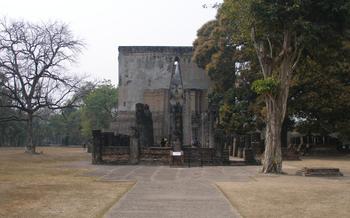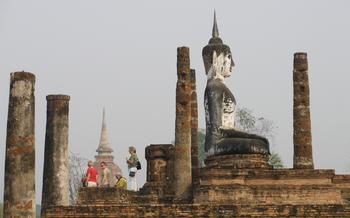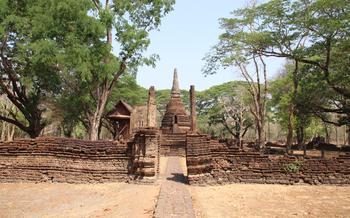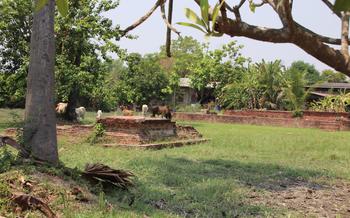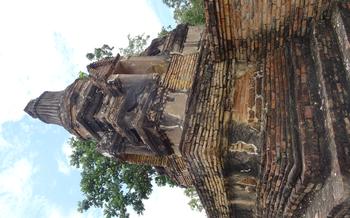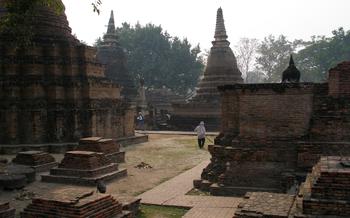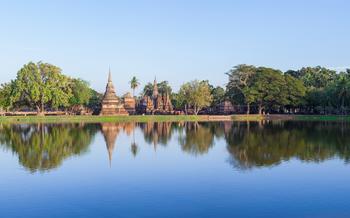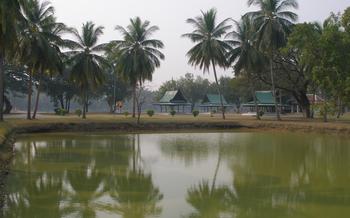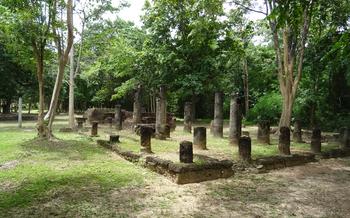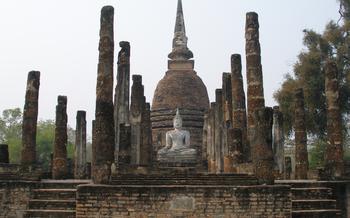
Wat Chom Chuen
- Historical Significance
- Spiritual Relevance
- Architectural Masterpiece: Unveiling the Splendors of Wat Chom Chuen
- Buddha Images and Statues
- Wall Paintings and Murals
- Ordination Hall (Ubosot)
- Viharn (Assembly Hall)
- Monastery Grounds
- Cultural Importance
- Visiting Hours and Etiquette
- Nearby Attractions: Exploring Sukhothai's Cultural Gems
- Insider Tip: Unveiling the Hidden Gem
Historical Significance
Wat Chom Chuen holds immense historical significance as a prominent temple and center for Buddhist teachings during the Sukhothai Kingdom. Founded in the 14th century, it played a crucial role in shaping the religious and cultural landscape of the kingdom. The temple's unique architectural style, characterized by its impressive prang (relic tower), distinguishes it from other temples in the region. Its well-preserved state offers a glimpse into the architectural achievements and spiritual practices of the Sukhothai era, making it a valuable historical site for visitors interested in Thailand's rich cultural heritage.
Spiritual Relevance
Wat Chom Chuen holds a profound spiritual significance for the Thai people, serving as a sacred center for Buddhist teachings and practices. According to Buddhist beliefs, the temple is believed to possess a powerful aura and energy that enhances meditation and spiritual growth. Devotees visit the temple to seek blessings, pray, and offer devotional offerings to the Buddha images. The temple's serene atmosphere and tranquil surroundings create an ideal environment for spiritual contemplation and reflection.
Special ceremonies and rituals are held throughout the year at Wat Chom Chuen, attracting both local and international visitors. The most significant event is the annual temple fair, which takes place around November, featuring colorful processions, traditional performances, and merit-making activities. During this time, the temple becomes a hub of spiritual celebration and community gathering, allowing visitors to immerse themselves in the vibrant Buddhist culture of Thailand.
Architectural Masterpiece: Unveiling the Splendors of Wat Chom Chuen
Wat Chom Chuen stands as a testament to the architectural brilliance of the Sukhothai era. Its stunning complex features an array of structures, each displaying intricate details and profound religious symbolism. The ordination hall, known as the ubosot, takes center stage with its majestic design. Its gable ends are adorned with delicate stucco ornamentation depicting mythical creatures and celestial beings, symbolizing the temple's sacred nature. The roofline is further enhanced by elegant chofas, or bargeboards, which gracefully curve upwards, adding a touch of grandeur to the structure. The viharn, or assembly hall, complements the ubosot with its spacious interior and intricate wall paintings that narrate Buddhist tales and legends. The chedi, or stupa, rises majestically behind the ubosot, its graceful form representing the Buddha's path to enlightenment. Its intricate finial, adorned with lotus petals and celestial motifs, symbolizes the Buddha's attainment of Nirvana. Each architectural element at Wat Chom Chuen is meticulously crafted, reflecting the deep-rooted spiritual beliefs and artistic prowess of the Sukhothai people.
Buddha Images and Statues
Wat Chom Chuen houses a remarkable collection of Buddha images and statues, each possessing unique artistic and spiritual significance. These sacred figures are crafted from various materials, including bronze, stone, and wood, showcasing the diverse craftsmanship of the Sukhothai era. The postures, styles, and expressions of the Buddha images vary, reflecting different aspects of Buddhist teachings and beliefs.
Some of the most notable Buddha images at Wat Chom Chuen include the majestic bronze statue of the seated Buddha, known as "Phra Achana," which exudes an aura of serenity and compassion. The "Phra Si Sakyamuni" statue, carved from white marble, represents the historical Buddha in a standing posture, symbolizing strength and determination. The "Phra Sangkachai" statue, with its distinctive pot-bellied figure, is revered for bringing good fortune and prosperity.
These Buddha images are not mere works of art; they hold deep religious significance for Thai people. Devotees often pay homage to the Buddha statues, offering prayers, flowers, and incense. They believe that by venerating these sacred figures, they can receive blessings, protection, and guidance on their spiritual journey.
Wall Paintings and Murals
The walls of Wat Chom Chuen are adorned with exquisite wall paintings and murals that narrate stories and illustrate Buddhist teachings. These colorful and intricate artworks depict scenes from the life of Buddha, as well as Jataka tales and various other legends. The paintings showcase the exceptional artistic skills of the ancient Thai craftsmen and provide valuable insights into the religious beliefs and practices of the Sukhothai period.
The murals at Wat Chom Chuen are not merely decorative but hold profound religious significance. They serve as visual aids to help devotees understand and contemplate the teachings of Buddha. The stories and legends depicted in the paintings convey important moral lessons, emphasizing the virtues of compassion, generosity, and detachment. The murals also illustrate the karmic cycle and the consequences of one's actions, reminding devotees of the importance of righteous living.
Ordination Hall (Ubosot)
The ordination hall, or ubosot, is the heart of Wat Chom Chuen and holds great significance as the sacred space for Buddhist ordinations. Constructed according to strict religious guidelines, the ubosot is adorned with intricate carvings and symbolic elements that reflect its spiritual function.
The main feature of the ubosot is the large Buddha image, positioned at the far end of the hall. This image, known as the Phra Buddha Chinnarat, is a highly revered and sacred object of worship. Devotees often offer prayers and make merit to the Phra Buddha Chinnarat, seeking blessings and guidance in their spiritual journey.
During ordination ceremonies, young men who aspire to become Buddhist monks gather in the ubosot. Surrounded by their families and fellow devotees, they undergo a series of rituals and vows, committing themselves to the monastic life. The ubosot's serene and sacred atmosphere creates a profound and meaningful backdrop for this significant transition.
In addition to ordinations, the ubosot serves as a place for other important ceremonies and rituals. Monks gather here for chanting sessions, meditation, and the recitation of Buddhist scriptures. The ubosot is also used for special events such as festivals and holidays, when devotees come together to celebrate and honor the teachings of the Buddha.
Viharn (Assembly Hall)
The viharn, or assembly hall, at Wat Chom Chuen is a spacious and serene space where monks and devotees gather for various religious ceremonies and community events. Its architectural features include a high, sweeping roof supported by massive pillars, creating a sense of grandeur and openness. The interior of the viharn is adorned with intricate wall paintings and murals depicting scenes from the life of Buddha and Buddhist teachings. These artworks serve as a visual reminder of the temple's spiritual significance and provide a contemplative atmosphere for visitors.
The viharn at Wat Chom Chuen is not only a place of worship but also a venue for significant events and ceremonies throughout the year. One of the most important ceremonies held in the viharn is the annual ordination ceremony, where young men from the local community enter the Buddhist monastic order. During this ceremony, the candidates receive their saffron robes and take vows of celibacy, obedience, and poverty, marking the beginning of their journey as monks.
Visitors to Wat Chom Chuen are welcome to enter the viharn and observe the daily rituals and ceremonies that take place within. It is a unique opportunity to witness the vibrant spiritual traditions of Thai Buddhism and gain a deeper understanding of the temple's role as a center for community and religious life.
Monastery Grounds
The monastery grounds of Wat Chom Chuen exude an air of profound tranquility and serenity, inviting visitors to immerse themselves in spiritual contemplation. Lush gardens adorned with vibrant flowers and exotic plants create a picturesque backdrop for the temple complex. Tranquil ponds adorned with lotus blossoms reflect the shimmering sunlight, adding to the serene ambiance. Sacred trees, believed to possess spiritual significance, stand majestically within the grounds, providing shade and a sense of reverence. The harmonious blend of nature and spirituality creates an ideal setting for meditation and reflection, allowing visitors to find inner peace and connect with the divine.
Cultural Importance
Wat Chom Chuen plays a vital role in preserving and promoting Thai culture and heritage. The temple serves as a center for cultural events, festivals, and performances that showcase traditional Thai customs and traditions. Visitors can witness vibrant parades, classical Thai dance performances, and music concerts within the temple grounds.
The temple's annual Loi Krathong festival, held during the full moon of the 12th month of the Thai lunar calendar, attracts thousands of devotees and tourists alike. During this festival, people gather at the temple to release beautifully decorated krathongs, or floating baskets, into the moat surrounding the temple. This ritual symbolizes letting go of negative emotions and bad luck while making wishes for good fortune and prosperity.
Wat Chom Chuen also serves as a center for community gatherings and social interactions. The temple's spacious grounds provide a tranquil and serene setting for locals to gather for religious ceremonies, meditation retreats, and community events. The temple's monks are actively involved in community service, providing education, counseling, and support to the local community members.
Visiting Hours and Etiquette
Wat Chom Chuen welcomes visitors from all over the world, inviting them to explore its sacred grounds and soak in its spiritual atmosphere.
Nearby Attractions: Exploring Sukhothai's Cultural Gems
Beyond the serene grounds of Wat Chom Chuen, Sukhothai offers a wealth of historical and cultural attractions for visitors to explore. Just a short distance away, travelers can delve into the ancient city of Sukhothai Historical Park, a UNESCO World Heritage Site that houses the ruins of majestic temples, palaces, and fortifications. Among the highlights of the park are Wat Mahathat, with its iconic prang (spire), and Wat Si Chum, renowned for its colossal Buddha image.
For those seeking more spiritual experiences, the nearby Wat Traphang Thong Lang offers a unique glimpse into forest monastery life. Surrounded by lush greenery, this tranquil temple provides visitors with an opportunity to learn about Buddhist teachings and practices in a serene setting.
Nature enthusiasts can escape the hustle and bustle of the city at Ramkhamhaeng National Park, located approximately 30 kilometers from Sukhothai. This stunning park boasts diverse landscapes, including towering mountains, cascading waterfalls, and lush forests. Visitors can embark on hiking trails, admire the scenic views, and encounter a variety of wildlife.
To experience the local way of life, head to the vibrant Sukhothai Night Market. This bustling market offers an array of local delicacies, handicrafts, and souvenirs, providing visitors with a chance to immerse themselves in the vibrant culture of the region.
Whether you're seeking historical wonders, spiritual enlightenment, natural beauty, or local experiences, Sukhothai has something for every traveler. Combine your visit to Wat Chom Chuen with these nearby attractions to create a truly memorable and enriching journey through this captivating city.
Insider Tip: Unveiling the Hidden Gem
As you wander through the serene grounds of Wat Chom Chuen, take a moment to seek out a hidden gem tucked away amidst the tranquil gardens. Behind the main ordination hall, discover a secluded spot where a centuries-old Bodhi tree stands tall, its branches reaching towards the sky. Legend has it that this sacred tree is a descendant of the original Bodhi tree under which the Buddha attained enlightenment. Sit beneath its shade, close your eyes, and let the peaceful atmosphere envelop you as you meditate or simply soak in the spiritual energy. It's a truly special experience that will leave you feeling refreshed and connected to the essence of this sacred temple.
